by
A. Ben-Tuvia
Department of Zoology
The Hebrew University of Jerusalem
Jerusalem, Israel
Introduction
Fisheries biology investigations of the Bardawil Lagoon (Mediterranean coast of Sinai, Egypt) were carried out from December 1969 to April 1979, during the Israeli administration of this region. The present paper summarizes some of the information on the physical and biological aspects influencing fishery resources management for the Lagoon.
The main body of information on the Lagoon was given in internal reports in Hebrew by Ben-Tuvia and collaborators. A comprehensive summary and most of the bibliographic references pertinent to the Lagoon can be found in Ben-Tuvia (1979), Pisanty (1981) and Por and Ben- Tuvia (1981).
The Lagoon is a unique coastal water deeply influenced by human activities. The very existence of the Lagoon depends on man's interference and skill to provide favourable conditions for the growth of commercial fishes. Without the artificial openings in the sandy bar that separate the shallow depression from the Mediterranean Sea, the area in summer would be no more than a salty marsh.
Even with the two artificial openings the salinities were much higher than in the open Mediterranean Sea, fluctuating in the central section of the Lagoon between 45 and 65 percent, always considerably above the salinities of the parental sea. Higher salinities are detrimental to the fish stock. Therefore, it was essential to monitor salinities as a part of rational management in addition to monitoring fish population parameters (Gulland, 1974).
Geography and hydrographic features
The shallow, 0.5–1.5 m deep, hypersaline Bardawil Lagoon on the northern coast of Sinai covers an area of about 650 square km. It is separated from the open Mediterranean Sea by a long sand barrier in which two artificial openings, Boaz 1 and Boaz 2 are maintained (Figure 1). Because of the configuration of the terrain the natural opening, Zarnich, at the eastern corner of the Lagoon is not sufficient to enable proper flooding of the Bardawil depression.
Salinity was the most important abiotic factor influencing the ecological processes of the Lagoon and its fishery. It depended chiefly on the exchange of water through the two artificial openings (or inlets) in the bar and their periodical dredging.
Typical seasonal fluctuations of the salinities are shown in the example recorded for the year 1978 (Figure 2). The lowest values were recorded in the winter months and the highest during summer. Since there is no inflow of freshwater sources from the arid surroundings and the rate of evaporation is high, the salinities in general are much above the values of the eastern Mediterranean water masses. At the Boaz 1 and Boaz 2 openings the salinities are slightly over 40 percent but they increase with the distance from the openings. By determining the salinities at fixed stations across the Lagoon it was possible to evaluate the hydrographic conditions resulting from the state of the openings. Normal ecological conditions prevail when the salinity at the main water basin of the Lagoon (stations: Kalas, Rumia, Matiblis, Lashon 2) does not exceed 60 percent.
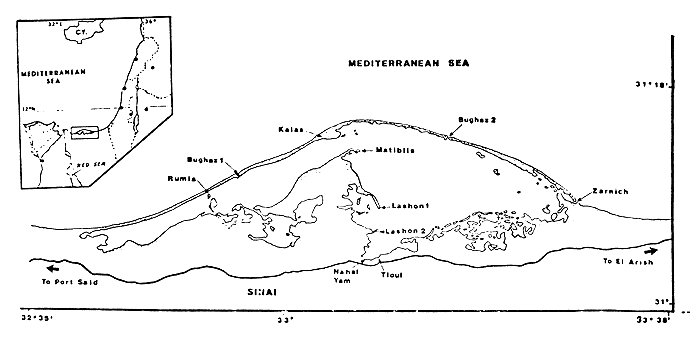
Figure 1 Map of the south-eastern Mediterranean and the Bardawil Lagoon showing the openings Boaz 1, Boaz 2, Zarnich and the main sampling stations
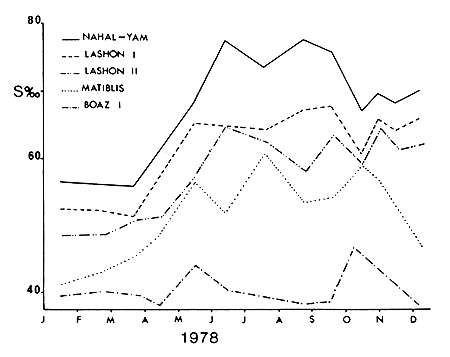
Figure 2 Monthly salinites at 5 stations recorded in 1978
The water tempertures of the Lagoon vary diurnally and seasonally. In Figure 3 averages of monthly surface water temperatures of Lashon 2, Matiblis, Haparsa and Rumia stations are summarized for the years 1973 and 1974. The lowest average temperature of 11.8°C was recorded for January and the highest, 30.6°C, for June. Meteorological data indicate that July and August have the highest average temperatures.
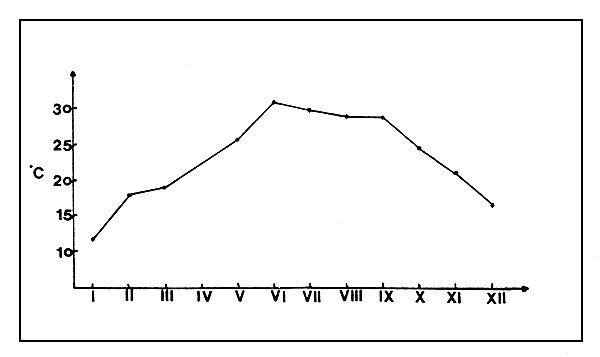
Figure 3 Average monthly surface temperatures recorded in 1973 and 1974 at Lashon 2, Matiblis and Rumia stations
Fishing methods
Three main fishing methods were employed in the Bardawil Lagoon in the years of the present investigations, 1969–1979:
Purse-seine, known locally under the Italian name of ‘cionciola’. The net is an adaptation of a purse-seine of the same name, commonly used along the coast of Israel for inshore-pelagic fish (Grofit, 1981). Its depth to length ratio is much less than in the Mediterranean purse-seine, about 1:9. This type of purseseine was introduced to the Lagoon in 1970. Each fishing unit consisted of about 11 fishermen using a motorized boat with an auxiliary skiff. The fishing was carried out in day time and each haul lasted about 30–45 minutes.
Trammel net, called locally ‘dabba’ or ‘ambatan’. They were set over-night by two fishermen using a small boat, usually motorized.
Beach-seine, called locally ‘jaraf’. This is a bagless drag seine, 1–2 km long, pulled by ropes to the beach by about 25 fishermen.
Handling was employed in winter, mostly near the openings, to catch the migrating seabass, Dicentrarchus labrax. Its catch, which constituted a small fraction of the total, was registered under the three other fishing methods.
Although basically the same fishing methods remained in use during most of the period of study, the fishing power of each unit progressively increased due to technical improvements. Engines were installed in all fishing vessels, permitting quick search for fish concentrations and more efficient fishing techniques. Thus, for example, the number of hauls carried out by a purse-seine fishing unit in a day's work increased from about 8 to 15. One fishing unit in 1977 acquired a power-block. There was a general tendency to employ longer beach-seines and a larger number of trammel-nets by each unit. I estimate that the fishing efficiency of each fishing unit increased close to 100 percent during the years 1970–1978. Since there was a constant demand for fish during these years, the fishing effort of each operational unit was close to its maximum fishing capacity, within the framework of the restrictions imposed by the general management policy and the availability of fish.
Catches
The statistics must be divided into two periods. For the period 1968–1972, no precise catch-composition data are available. Only during the second period of study, 1973–1978, was it possible to obtain catch statistics for the main species by years (Table 1). The best indication of the state of the Lagoon is the catch of Sparus aurata. There was a dramatic decrease in this catch during the period of excessive salinities in 1970–1972. It increased considerably during 1974–1978 when the fishing regulations were fully applied. Thus in 1971 the catch amounted to 181 t and in 1977 to 1,946 t. The actual catch of the whole Lagoon in 1977–1978 was higher than shown by about 200 t since the present statistics (Table 1) do not include the landings in the western section of the Lagoon after the temporary changes in the demarcation line of the border between Egypt and Israel in 1977.
Some data on catch per unit of effort are given in Pisanty (1981). As pointed out in the chapter on fishing gear, a correcting factor should be applied to take into account the introduction of larger nets and improved fishing methods in recent years. The fact remains that, in spite of heavy fishing, the total catch increased. However, it is evident from the accumulated data that the average size of Sparus aurata declined in 1977–1978 as compared with preceding years.
Fish fauna
The Bardawil Lagoon was built for the practical purpose of utilizing the stock of fish for food. The fish fauna originates from the adjacent Mediterranean Sea, in the same way as the sea water of the Lagoon was formed by the evaporation of the Mediterranean Sea water (Krumgalz et al., 1980).
Because of the high salinities and pronounced fluctuations of temperature, only a small number of species, about 10 percent of the adjacent coastal fish fauna, is able to inhabit the Lagoon. However, most of them and in particular all commercial fish do not reproduce in the Lagoon.
The Lagoon itself is situated in an unusual geographical position, influenced by the proximity of the man-made Suez Canal and man-regulated Nile River, where the impoverished eastern Mediterranean fauna meet the Suez Canal immigrants from the Red Sea. The number of Red Sea immigrants, in proportion to the total number of species, is higher in Bardawil than in the eastern Mediterranean Sea. From the total of 36 Red Sea species, 17 have been collected in Bardawil Lagoon, including two species (Crenidens crenidens and Authistes puta) that have not as yet been found along the other sections of the Mediterranean coast. The Red Sea species in Bardawil constitute about one quarter of the total number of species collected. In the Mediterranean Sea they constitute only 11 percent of the total (Ben-Tuvia, in press).
The Bardawil fish fauna can be divided conveniently into three categories: (i) commercial species; (ii) common non-commercial species; (iii) rare species.
Table 1. Catch composition according to species and fishing gear in Bardawil Lagoon during the period 1968–1978
| 1968 | 1969 | 1970 | 1971 | 1972 | 1973 | 1974 | 1975 | 1976 | 1977 | 1978 | |
| SPECIES | |||||||||||
Sparus aurata | 694 | 1,006 | 345 | 181 | 520 | 825 | 931 | 1,322 | 1,226 | 1,946 | 1,625 |
Mugil cephalus | 387 | 335 | 421 | 432 | 346 | 369 | |||||
other Mugilids | 248 | 314 | 76 | 143 | 102 | 57 | |||||
Dicentrarchus spp. | 239 | 168 | 216 | 225 | 169 | 173 | |||||
Solea solea | 38 | 67 | 58 | 55 | 59 | 48 | |||||
| Total | 851* | 1,387* | 1,497* | 728* | 1,303* | 1,737 | 1,815 | 2,093 | 2,081 | 2,622** | 2,272** |
| NUMBER OF UNITS | |||||||||||
purse seine | - | - | - | - | - | 20 | 22 | 22 | 27 | 31 | 30 |
trammel net | - | 41 | 79 | - | - | 146 | 179 | 213 | 209 | 250 | 306 |
beach seine | 66 | 63 | 28 | - | - | 42 | 37 | 21 | 15 | 10 | 3 |
* Includes Sparus aurata and unsorted fish
** Does not include an additional catch of about 200 t at the western section of the Lagoon
Among the commercial fishes three groups are important: Sparus aurata, six species of Migilidae and Dicentrarchus labrax. They constitute about 95 percent of the total. The other fishes of some commercial importance are Solea solea, Dicentrarchus punctatus, Argyrosomus regius, Umbrina cirrosa and Epinephelus aeneus. This is in striking contrast to the commercial catches of the open Mediterranean Sea, which usually contain a great number of species.
The gilthead seabream (Sparus aurata) of the family Sparidae (‘denis’ in local Arabic; ‘sparus zahuv’ in Hebrew) was the most important commercial fish in the Lagoon, constituting in recent years about 70 percent of the total landings. Its life history and fisheries biology in the Bardawil Lagoon have been investigated from December 1969 to April 1979 (Ben-Tuvia, 1979; Ben-Tuvia and Golani, 1979).
The rate of growth, based on otolith readings and corroborative evidence from length-frequency measurements, is given in Figure 4. The catch was composed chiefly of fish 180–300 mm, belonging to age groups 0–4. Under pressure of the increasing fishing effort, the average size of the seabream decreased in recent years.
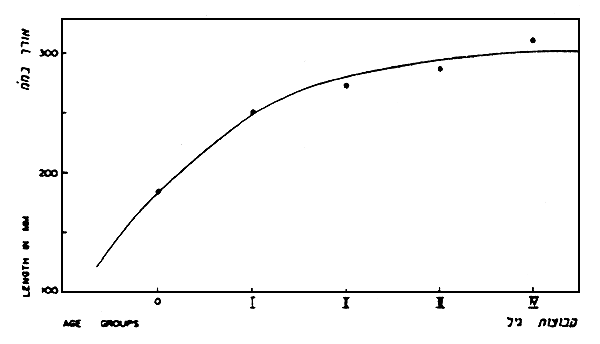
Figure 4 Growth rate of Sparus aurata
The following values for the parameters in the equation W = KLn (weight-length relationship) were estimated from the data: K = 3.73 · 10-5; n = 2.81 (Figure 5).
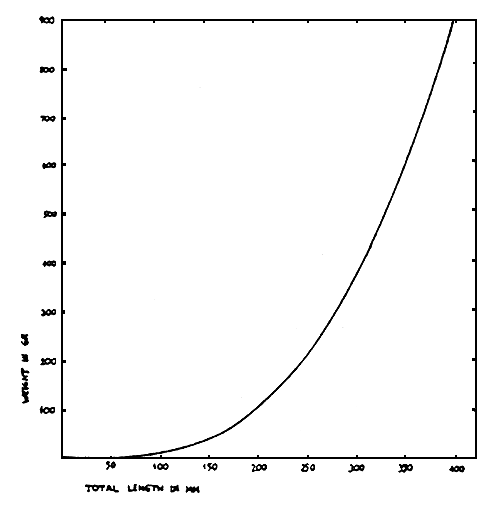
Figure 5 Length-weight relationship of Sparus aurata
The reproduction takes place in the Mediterranean Sea. All the adult fish, approaching the end of the second year and older, leave the Lagoon in November-December and evidently return to the Lagoon after spawning during the second half of February.
The silverside, Atherina boyeri, of the family Atherinidae, is a small fish which does not grow in Bardawil to a length of more than 55 mm. It is one of the most common fish in the Lagoon but as yet it has not been commercially exploited.
The life history of silverside was studied by Gon and Ben-Tuvia (in press) from samples collected with an experimental beach-seine in 1973 and 1974. Age determinations based on otolith reading and length-frequency distributions indicate that the Bardawil population is mostly composed of 0-age group. Older fish were few and their maximum age was estimated at 18 months. The fish feeds on zooplankton, mainly amphipods and copepods. Spawning takes place at least from March to September.
The biology of Dicentrarchus labrax was studied by Blostein (1976) and the biology of Mugil cephalus by Azoury (1979).
Maintenance of favourable physical conditions
As mentioned above, the two artificial openings - Boaz 1 and Boaz 2 - are essential for flooding the Bardawil depression and ensuring a vigorous exchange of the highly saline water of the Lagoon and the Mediterranean Sea. It was pointed out by Kapetsky (1981) that this type of management based on hydraulic engineering is a very important means for developing fisheries in both brackish and hypersaline lagoons.
Movements of sediments by currents and wave action along the coast (Nir, 1973; Neev and Ben-Avraham, 1977) causes silting of the two openings. It was estimated that the yearly accumulation of sand in these openings amounted to about 700 cubic metres (Pisanty, 1981). The state of silting could be clearly seen by aerial photography.
Restrictions in water exchange between the Lagoon and the sea resulted in an increase of salinities, having an adverse effect on the commercial fish stocks. This was illustrated by the situation of the Lagoon in the years 1970 and 1971. During the summer and autumn of 1970 the salinities in the central section of the Lagoon reached the value of 80 percent. The catch of Sparus aurata in 1971 was reduced to 180 t, less than one-fifth of the quantity caught in 1969 and less than one-tenth of the 1977–1978 catch.
Dredging of the openings was the most expensive part of the maintenance of the Lagoon, amounting to 80 percent of the total cost of the up-keep. Therefore it was important to keep the amount of dredging at a minimum, whilst maintaining favourable physical and biological conditions for a prosperous fishery. The experience of the present study indicates that dredging only every second year has no apparent ill-effect on the yield. In theory the amount of sand removed from the openings should be equal to the rate of sedimentation. From the accumulated experience it seems that dredging of 750,000 cubic metres once in two years was satisfactory but long-term observations are still needed. Other technical solutions for preventing the silting of the openings and finding more efficient ways of removing the accumulated sand were considered but not fully elaborated. In general terms it was agreed by experts that protective walls at the entrance to the openings should be helpful. One proposal is a funnel-like sand trap built at the opening, from which the accumulated sand would be pumped out continuously.
Mesh size and minimum legal size of fish
Studying the biology of commercial fishes of the Bardawil Lagoon was an important step in establishing guidelines for fishery-regulation measures. After a series of experiments, a minimum mesh size of 70 mm stretch was established in all nets. Such a mesh-eye allows the escapement of Sparus aurata below the minimum legal size of 180 mm total length, which corresponds roughly to an average length of the 0-age group at the end of first summer (Ben-Tuvia, 1979).
Additional regulations were adopted to reduce the fishing mortality on fishes belonging to 0-age group. It was found that beach seines catch a high proportion of small fish even with a 70 mm mesh size. The net is used in shallow waters, often in places where there is a high concentration of juvenile fish. The meshes are usually blocked by seaweeds and are less selective. Fishing with beach seines was often carried out with illegal mesh sizes in remote places where supervision was difficult. For all these reasons beach seines were progressively replaced by other fishing methods. In 1978 only three beach-seine units were left.
Limits on fishing power
Fishing in the Bardawil Lagoon was profitable according to the standards of the local population and served as an important source of employment. There was a steady market for the catch, for local consumption and for export. Therefore, there was a continuous pressure to allow more units to operate. Thus a policy was adopted of strict licence limitation for each fishing method.
The licence for the fisherman was valid for the whole year but, for the fishing unit, it has to be renewed each month. The number of fishing units was higher than the number of permits. Thus there was some rotation and queuing for the permit to fish during most of the months of the fishing season.
The replacement of beach seines by other fishing methods was based on an estimate that its efficiency equals 1.5 purse-seine and 8 trammel-net units.
It was also necessary to limit the size of trammel-nets employed by each unit to a maximum of 1,000 m and that of purse-seine to 400 m.
Closed seasons
Fishing was prohibited during the winter months, mostly from the beginning of November to the end of February. This closure was introduced for three reasons:
Spawning migrations take place in winter. All adult fish of Sparus aurata approaching the end of their second year (age group 1) or older leave the Lagoon in November and December and spawn in the coastal waters of the Mediterranean Sea. It seems to be sound to allow the fish to migrate freely for reproduction.
At the end of the spawning season, about mid-February the fish return to the Lagoon but are lean, losing apparently much weight during the spawning processes. Upon returning to the Lagoon the fish feed intensively and quickly regain their normal weight. Thus it seems advisable not to start the fishing in the Lagoon before March.
Only one-year old fish, of 170–230 mm size, remain in the Lagoon during the winter months. For better exploitation of the stock it seems advisable to postpone their capture.
The winter period coincides with the spawning migrations of another commercial fish, Dicentrarchus labrax.
Areas of interest for future investigations
The maintenance and further development of the Bardawil Lagoon fishery resources will require additional studies in the following fields of research:
Silting processes of the openings and exchange of water masses between the Lagoon and the open sea;
Monitoring salinities in various seasons and localities;
Analysis of the impact of the fishery on the stock, taking into account the technological advantages and biological influence of various fishing gears;
Better knowledge of the reproductive cycle of the main commercial fishes (gilthead bream, flathead grey mullet and sea-bass);
Behaviour and survival of the gilthead bream in the open sea during the spawning season of the winter months;
Tagging programme for the main commercial fishes in order to learn about their mortalities and migrations.
Better understanding of the population dynamics of commercial fishes is essential not only for the rational exploitation of the Bardawil Lagoon, but also for better management of other coastal lagoons in the eastern Mediterranean, that are predominantly inhabited by similar species. At the same time it will be important to develop fishing gear suitable for shallow lagoons and to analyse economic factors affecting the fishery.
Acknowledgements
I wish to thank the Civil Authorities of the North Sinai and the Israel Ministry of Agriculture for their financial support of the research project; the Department of Fisheries, the Israel Oceanographic and Limnological Research and the Hebrew University of Jerusalem for their assistance; Y. Maoz for his interest and encouragement; A. Baranes, Abigail Gilboa, Z. Herman, Dr. A. Tendler and A. Wilamovsky for research assistance; D. Golani for his research and technical assistance, especially helpful in preparation of the present paper; A. Niv for photography; and M. Ben-Yami for close cooperation in the early stages of planning and research work.
References
Azoury, R., 1979 Age, growth and steroids in the ovary of the gray millet, Mugil cephalus L., at various stages of development from the Bardawil Lagoon. M.Sc. Thesis, Hebrew University of Jerusalem, 59 p. (in Hebrew)
Ben-Tuvia, A., 1979 Studies of the population and fisheries of Sparus aurata in the Bardawil Lagoon, eastern Mediterranean. Invest.Pesq.,Barc., 43(1):43–67
Ben-Tuvia, A., The Mediterranean Sea. B. Biological aspects. In Estuaries and enclosed seas, edited by B.H. Ketchum. Amsterdam, Elsevier, pp.239–51
Ben-Tuvia, A. and D. Golani, 1979 Ten years of fisheries biology investigations of the Bardawil Lagoon. Fish.Fishbreeding Israel, 14(2):29–37 (in Hebrew with English abstr.)
Blostein, I., 1976 The biology of Dicentrarchus labrax in the Bardawil Lagoon. M.Sc. Thesis, Hebrew University of Jerusalem, 42 p. (in Hebrew)
Gon, O. and A. Ben-Tuvia, The biology of Boyer's sand smelt, Atherina boyeri Risso in the Bardawil Lagoon on the Mediterranean coast of Sinai. J.Fish Biol., (in press)
Grofit, E., 1981 The artisanal coastal fishery in the eastern Mediterranean. In Management of living resources in the Mediterranean coastal area. Stud.Rev.Gen.Fish.Counc.Mediterr., (58): 1–22
Gulland, J.A., 1974 Guidelines for fishery management. Rome, FAO. IOFC/DEV/74/36:84 p.
Kapetsky, J.M., 1981 Some considerations for the management of coastal lagoons and estuarine fisheries. FAO Fish.Tech.Pap., (218):47 p. (Issued also in French and Spanish)
Krumgalz, B.S., H. Hornung and O.H. Oren, 1980 The study of a natural hypersaline lagoon in a desert area (Bardawil Lagoon in northern Sinai). Estuar.Coast.Mar.Sci., (10):403–15
Neev, D. and Z. Ben-Avraham, 1977 The Levantine countries: the Israeli coastal region. In The Ocean basins and margins, edited by E.M. Nairn, W.H. Kanes and F.G. Stehli. New York, Plenum Publishing Corporation, pp.355–77
Nir, Y., 1973 Geological history of the recent and subrecent sedimnents of the Israel Mediterranean shelf and slope. Rep.Geol.Surv.,Israel, (MG/73/2):179 p.
Pisanty, S., 1981 The fishery and management of the hypersaline lagoon of Bardawil. In GFCM, Management of living resources in the Mediterranean coastal area. Stud.Rev.Fish.Counc. Mediterr., (58):35–73
Por, F.D. and A. Ben-Tuvia, 1981 The Bardawil Lagoon (Sirbonian Lagoon) of North Sinai - a summing up. Rapp.P.-V.Réun.CIESM, 27(4):101–7